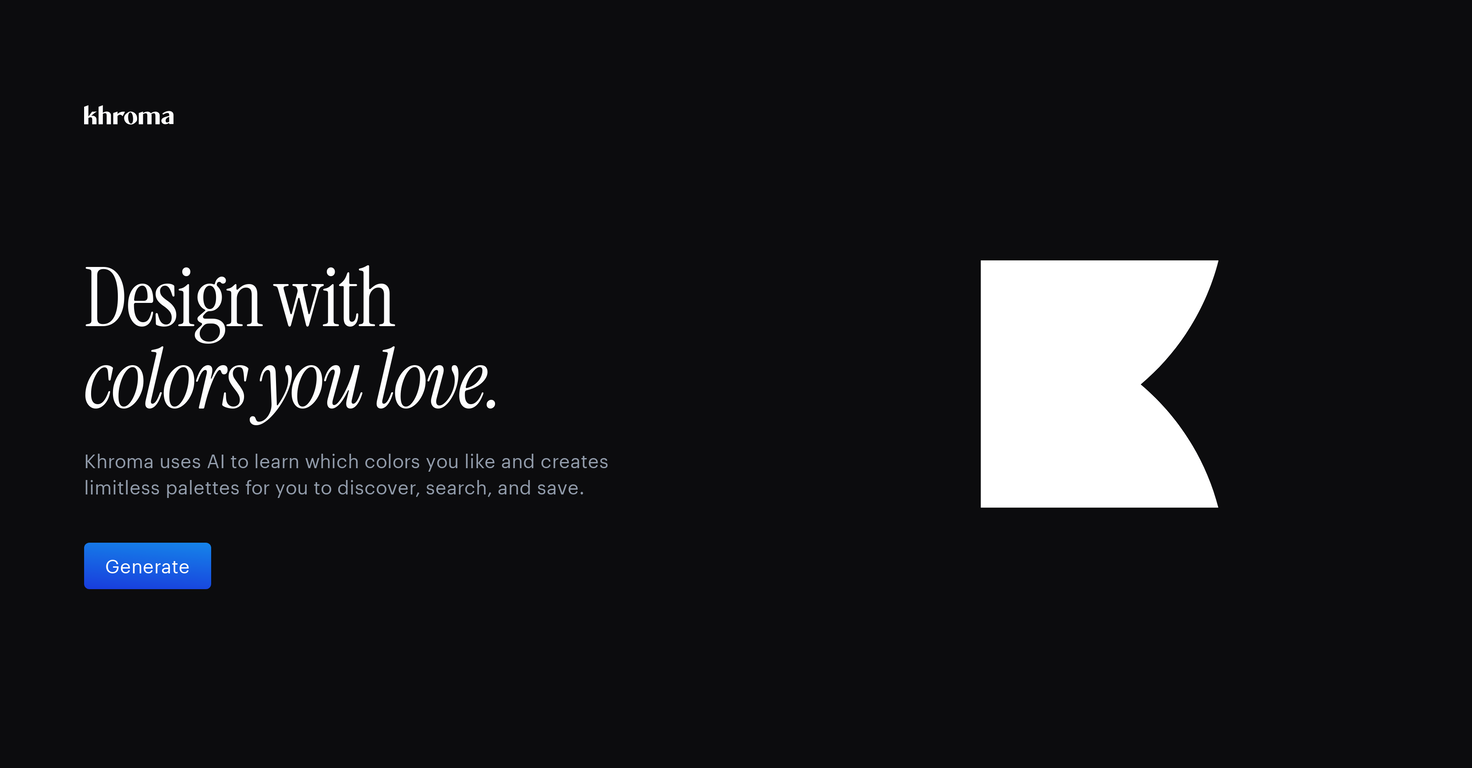
Khroma: Complete Buyer's Guide
AI-powered color palette generator
Khroma positions itself as a specialized AI-powered color palette generator designed for individual designers and small teams seeking personalized color intelligence through neural network technology. Unlike comprehensive design platforms, Khroma concentrates exclusively on color selection capabilities, learning individual aesthetic preferences through an initial training process where users select 50 preferred colors [37][55].
Market Position & Maturity
Market Standing
The platform competes across multiple solution tiers with distinct positioning advantages through its zero-cost access model and personalization focus [39][40][43].
Company Maturity
Khroma's operational model centers on browser-based deployment with local storage dependency, indicating a lean technical infrastructure approach [38][40].
Growth Trajectory
The AI-powered design tools market is projected to increase among designers in 2025 [2], creating favorable conditions for focused solutions like Khroma's personalized approach.
Industry Recognition
Research indicates positive reception for Khroma's personalization approach and generation capabilities [37][48].
Strategic Partnerships
Khroma functions effectively as an ideation accelerator within hybrid workflows rather than comprehensive color management solution [40][48][52].
Longevity Assessment
The free model's sustainability and long-term development trajectory remain unclear without traditional revenue visibility [40][55].
Proof of Capabilities
Customer Evidence
Khroma demonstrates effectiveness through its personalized neural network approach and documented user engagement patterns [37][48].
Quantified Outcomes
Algorithm accuracy correlates directly to initial color selection diversity [38][56].
Case Study Analysis
Effective Khroma deployments involve stakeholder collaboration during initial color training to ensure brand alignment [37].
Market Validation
Limited data suggests higher engagement rates with AI-generated palettes compared to conventional methods [38][47].
Competitive Wins
Comparative analysis shows Khroma's personalization focus differentiating it from aggregate trend-following competitors [37][55].
AI Technology
Khroma's neural network architecture represents a focused approach to AI-powered color intelligence, employing machine learning algorithms that process user-selected colors to predict and generate preferred combinations while filtering out disliked hues [38][55].
Architecture
The platform operates entirely through browser-based deployment, utilizing local storage to retain user preferences and generated palettes [38][55].
Primary Competitors
Enterprise solutions like Adobe Color, collaboration-focused tools like Coolors, and specialized AI tools like Huemint [42][48][51].
Competitive Advantages
Khroma's zero-cost access model provides immediate accessibility without licensing barriers [39][40][43].
Market Positioning
Khroma positions itself as a personalized ideation accelerator within hybrid workflows rather than comprehensive color management solution [40][48][52].
Win/Loss Scenarios
Khroma wins in scenarios involving individual designers prioritizing personalization over collaboration [37][39][43][53].
Key Features

Pros & Cons
Use Cases
Featured In Articles
Comprehensive analysis of AI Color Palette Tools for AI Design for AI Design professionals. Expert evaluation of features, pricing, and implementation.
How We Researched This Guide
About This Guide: This comprehensive analysis is based on extensive competitive intelligence and real-world implementation data from leading AI vendors. StayModern updates this guide quarterly to reflect market developments and vendor performance changes.
56+ verified sources per analysis including official documentation, customer reviews, analyst reports, and industry publications.
- • Vendor documentation & whitepapers
- • Customer testimonials & case studies
- • Third-party analyst assessments
- • Industry benchmarking reports
Standardized assessment framework across 8 key dimensions for objective comparison.
- • Technology capabilities & architecture
- • Market position & customer evidence
- • Implementation experience & support
- • Pricing value & competitive position
Research is refreshed every 90 days to capture market changes and new vendor capabilities.
- • New product releases & features
- • Market positioning changes
- • Customer feedback integration
- • Competitive landscape shifts
Every claim is source-linked with direct citations to original materials for verification.
- • Clickable citation links
- • Original source attribution
- • Date stamps for currency
- • Quality score validation
Analysis follows systematic research protocols with consistent evaluation frameworks.
- • Standardized assessment criteria
- • Multi-source verification process
- • Consistent evaluation methodology
- • Quality assurance protocols
Buyer-focused analysis with transparent methodology and factual accuracy commitment.
- • Objective comparative analysis
- • Transparent research methodology
- • Factual accuracy commitment
- • Continuous quality improvement
Quality Commitment: If you find any inaccuracies in our analysis on this page, please contact us at research@staymodern.ai. We're committed to maintaining the highest standards of research integrity and will investigate and correct any issues promptly.